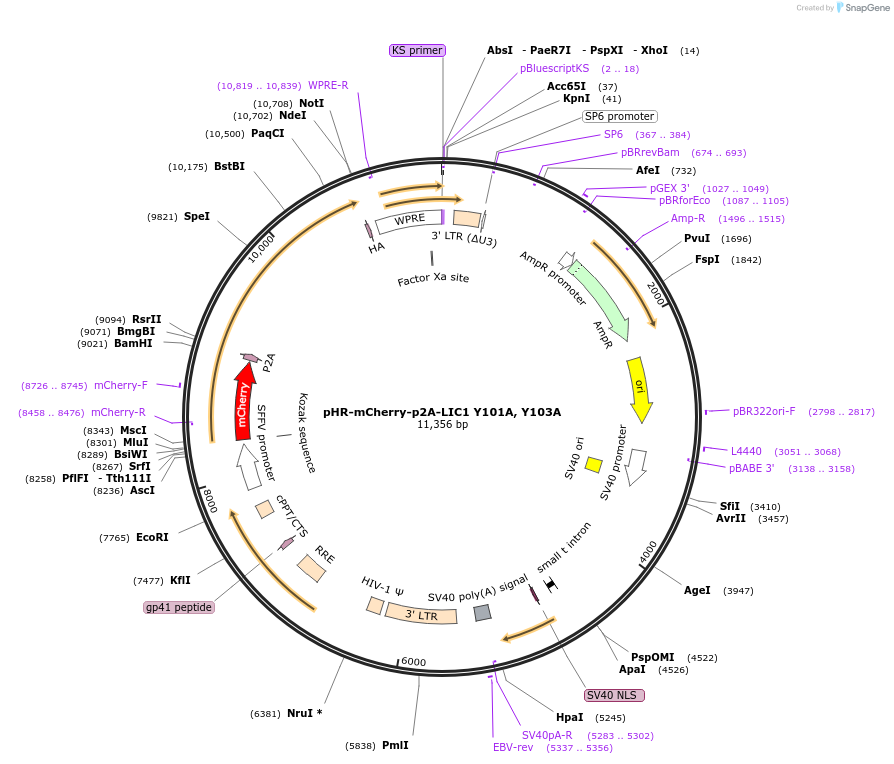We narrowed to 5,340 results for: 290
-
Plasmid#132202PurposeGateway entry clone with codon-optimized ORF sequence for subcloning into custom expression vectorsDepositorInsertSLC43A3 (SLC43A3 Human)
ExpressionMammalianAvailable SinceOct. 28, 2019AvailabilityIndustry, Academic Institutions, and Nonprofits -
TFORF0572
Plasmid#141642PurposeLentiviral vector for overexpressing the MEOX1 transcription factor ORF with a unique 24-bp barcode. Barcodes facilitate identification of transcription factors in pooled screens.DepositorAvailable SinceJan. 5, 2023AvailabilityAcademic Institutions and Nonprofits only -
CDK2 gRNA (BRDN0001148866)
Plasmid#77191Purpose3rd generation lentiviral gRNA plasmid targeting human CDK2DepositorAvailable SinceJuly 6, 2016AvailabilityAcademic Institutions and Nonprofits only -
U6-hGRIN2B-CAG-ps-SaCas9
Plasmid#102853PurposeA single-chain light-controllable dSaCas9 with pdDronpa1 domains for hGRIN2B gene editingDepositorInsertsa-hGRIN2B-sgRNA; dSaCas9; pdDronpa1 (GRIN2B Synthetic, S. aureus, Human)
UseCRISPRTags3X Flag and NLSExpressionMammalianPromoterU6 promoter;Available SinceNov. 27, 2017AvailabilityAcademic Institutions and Nonprofits only -
COPE_pLX307
Plasmid#98327PurposeLentiviral expression of COPEDepositorAvailable SinceAug. 23, 2017AvailabilityAcademic Institutions and Nonprofits only -
LSB-hsa-miR-331-3p
Plasmid#103444PurposeUsed to sense miRNA activity using fluorescence based tools. hsa-miR-331-3p target in 3' UTR of of mKate. miRNA activity can be measured by the repression of mKate2 relative to EBFP2 fluorescent proteins . Plasmid is inherently unstable; please see Depositor CommentsDepositorInserthsa-miR-331-3p target (MIR331 Human)
UseSynthetic BiologyExpressionMammalianPromoterEF-1aAvailable SinceNov. 26, 2018AvailabilityAcademic Institutions and Nonprofits only -
pLV Myc-LBR
Plasmid#175102PurposeLentiviral expression of Myc-tagged mouse LbrDepositorAvailable SinceOct. 26, 2021AvailabilityAcademic Institutions and Nonprofits only -
CDK2_HUMAN_D0
Plasmid#79726PurposeThis plasmid encodes the kinase domain of CDK2. Intended for co-expression with Lambda Phosphatase that accompanies this set to enhance bacterial kinase expression.DepositorAvailable SinceNov. 21, 2016AvailabilityAcademic Institutions and Nonprofits only -
pHR-mCherry-p2A-LIC1 Y101A, Y103A, W120A
Plasmid#74606Purposeexpresses LIC1 in mammalian cells; HA-tagged; point mutants that abrogate binding to dyneinDepositorInsertfull length human dynein light intermediate chain 1 Y101A, Y103A, W120A (DYNC1LI1 Human)
UseLentiviralTagsHA tagExpressionMammalianMutationY101A, Y103A, W120APromoterSFFVAvailable SinceJuly 6, 2016AvailabilityAcademic Institutions and Nonprofits only -
pDONR221-SLC15A5_STOP
Plasmid#161088PurposeGateway entry clone with codon-optimized ORF sequence for subcloning into custom expression vectors. Contains a STOP codon at the end of the codon-optimized ORF sequence.DepositorInsertSLC15A5 (SLC15A5 Human)
ExpressionMammalianAvailable SinceJune 21, 2021AvailabilityIndustry, Academic Institutions, and Nonprofits -
pHR-mCherry-p2A-LIC1 Y101A, Y103A
Plasmid#74605Purposeexpresses LIC1 in mammalian cells; HA-tagged; point mutants that abrogate binding to dyneinDepositorInsertfull length human dynein light intermediate chain 1 Y101A, Y103A (DYNC1LI1 Human)
UseLentiviralTagsHA tagExpressionMammalianMutationY101A, Y103APromoterSFFVAvailable SinceJuly 6, 2016AvailabilityAcademic Institutions and Nonprofits only -
pCAFNF-PSDd1.2-GFP
Plasmid#125581PurposeFlp-dependent expression of PSD d1.2-GFP (a deletion mutant of PSD-95 fused to GFP) in mammalian cells.DepositorAvailable SinceJuly 8, 2019AvailabilityAcademic Institutions and Nonprofits only -
MSCV-NSD3-short W284A
Plasmid#72551Purposeexpresses 3*FLAG tagged human NSD3-short with W284A mutationDepositorInsertNSD3-short (NSD3 Human)
UseRetroviralTags3*FLAGExpressionMammalianMutationW284APromoterLTRAvailable SinceJan. 20, 2016AvailabilityAcademic Institutions and Nonprofits only -
Lenti-sgNcoa6#2/Cre
Plasmid#173604PurposeExpresses a Ncoa6-targeting gRNA and Cre-recombinaseDepositorInsertgRNA targeting Ncoa6 (Ncoa6 Mouse)
UseCRISPR, Cre/Lox, and LentiviralAvailable SinceJune 7, 2022AvailabilityAcademic Institutions and Nonprofits only -
Lenti-sgNcoa6#1/Cre
Plasmid#173603PurposeExpresses a Ncoa6-targeting gRNA and Cre-recombinaseDepositorInsertgRNA targeting Ncoa6 (Ncoa6 Mouse)
UseCRISPR, Cre/Lox, and LentiviralAvailable SinceJune 7, 2022AvailabilityAcademic Institutions and Nonprofits only -
pPB CAG Gfi1:FLAG-IRES-EGFP
Plasmid#153945PurposepiggyBac transposon vector with CAG promoter expressing FLAG-tagged Gfi1 and EGFPDepositorAvailable SinceJuly 31, 2020AvailabilityAcademic Institutions and Nonprofits only -
AAV2_hSyn_Aurora_Citrine
Plasmid#98217PurposeRed-shifted artificial anion conducting channelrhodopsin (aACR). Activation up to 600 nm; off-kinetics 260 ms. Codon optimized for mammalian expression.DepositorInsertSynthetic construct Aurora gene
UseAAVTagsCitrineExpressionMammalianMutationV59S, E83N, E90Q, E101S, V117R, E123S, P242R, A24…Promoterhuman synapsinAvailable SinceAug. 22, 2017AvailabilityAcademic Institutions and Nonprofits only -
AAV2_hSyn_iChloC_CA_Citrine
Plasmid#98220PurposeSlow cycling (open for minutes) step-function artificial anion conducting channelrhodopsin (aACR). High light sensitivity. Activation with blue to green light, inactivation max with 605 nm (accelarates closure to ms). Codon optimized for mammalian expression.DepositorInsertSynthetic construct iChloC_C128A gene
UseAAVTagsCitrineExpressionMammalianMutationE83Q, E90R, E101S, C128A, T159C, D156NPromoterhuman synapsinAvailable SinceOct. 23, 2017AvailabilityAcademic Institutions and Nonprofits only -
TFORF0507
Plasmid#143035PurposeLentiviral vector for overexpressing transcription factor ORFs with unique 24-bp barcodes. Barcodes facilitate identification of transcription factors in pooled screens.DepositorAvailable SinceApril 27, 2023AvailabilityAcademic Institutions and Nonprofits only -
TFORF0347
Plasmid#143398PurposeLentiviral vector for overexpressing transcription factor ORFs with unique 24-bp barcodes. Barcodes facilitate identification of transcription factors in pooled screens.DepositorAvailable SinceApril 27, 2023AvailabilityAcademic Institutions and Nonprofits only





















